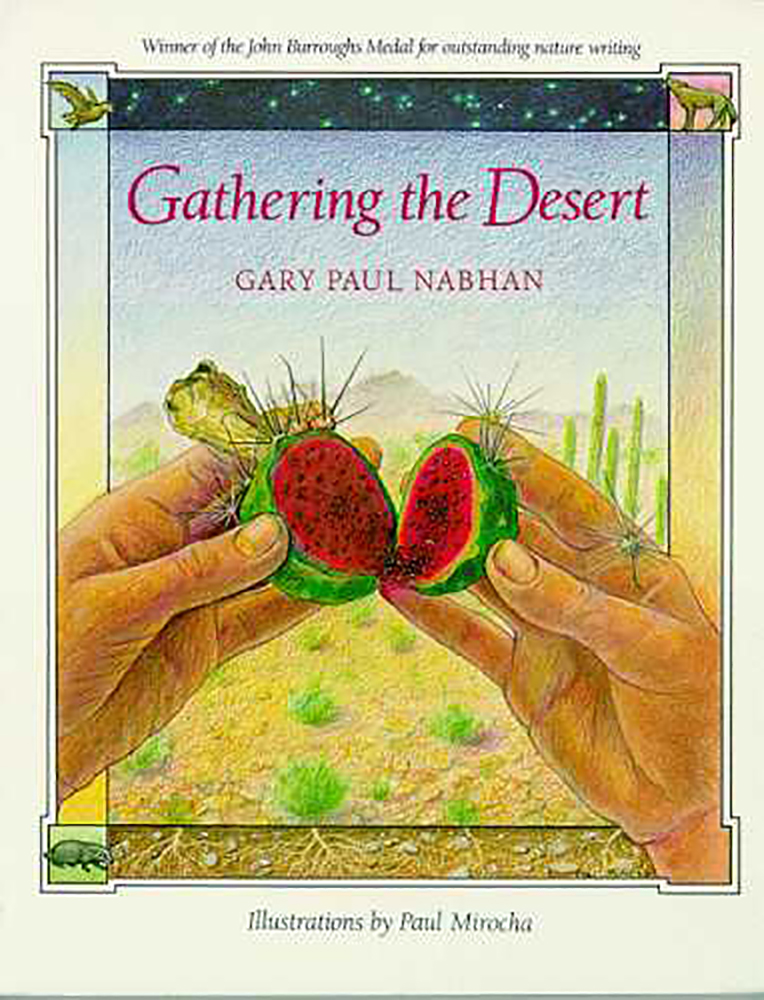Gathering the Desert
Paperback ($24.95), Ebook ($24.95)
Buy
Winner of the John Burroughs Association’s John Burroughs Medal for natural history writing and a Southwest Book Award from the Border Regional Library Association
To the untrained eye, a desert is a wasteland that defies civilization; yet the desert has been home to native cultures for centuries and offers sustenance in its surprisingly wide range of plant life. Gary Paul Nabhan has combed the desert in search of plants forgotten by all but a handful of American Indians and Mexican Americans. In Gathering the Desert readers will discover that the bounty of the desert is much more than meets the eye—whether found in the luscious fruit of the stately organpipe cactus or in the lowly tepary bean.
Nabhan has chosen a dozen of the more than 425 edible wild species found in the Sonoran Desert to demonstrate just how bountiful the land can be. From the red-hot chiltepines of Mexico to the palms of Palm Springs, each plant exemplifies a symbolic or ecological relationship which people of this region have had with plants through history. Each chapter focuses on a particular plant and is accompanied by an original drawing by artist Paul Mirocha. Word and picture together create a total impression of plants and people as the book traces the turn of seasons in the desert.
To the untrained eye, a desert is a wasteland that defies civilization; yet the desert has been home to native cultures for centuries and offers sustenance in its surprisingly wide range of plant life. Gary Paul Nabhan has combed the desert in search of plants forgotten by all but a handful of American Indians and Mexican Americans. In Gathering the Desert readers will discover that the bounty of the desert is much more than meets the eye—whether found in the luscious fruit of the stately organpipe cactus or in the lowly tepary bean.
Nabhan has chosen a dozen of the more than 425 edible wild species found in the Sonoran Desert to demonstrate just how bountiful the land can be. From the red-hot chiltepines of Mexico to the palms of Palm Springs, each plant exemplifies a symbolic or ecological relationship which people of this region have had with plants through history. Each chapter focuses on a particular plant and is accompanied by an original drawing by artist Paul Mirocha. Word and picture together create a total impression of plants and people as the book traces the turn of seasons in the desert.
“Fascinating reading for anyone interested in human ecology or ethnobotany . . . a splendid way to learn to love—and save—the deserts.”—Natural History
“Nabhan has chosen a dozen of the more than 425 edible wild species found in the desert to demonstrate just how bountiful the land can be. . . . A rich blend of scientific facts and observation.”—Choice
“The desert will never look the same once you've seen it through the eyes of Gary Paul Nabhan. . . . With the style of a storyteller and with accompanying drawings by Paul Mirocha, Nabhan shows that the desert is anything but barren.”—Rodale’s Organic Gardening
“This gentle blend of history, scholarship and country yarns makes for a book that entertains while it teaches.”—Whole Earth Review
“If placed in the middle of this environment, how well would we fare? Nabhan becomes our guide. The empty baskets we bring to this book are gradually filled with seeds from each chapter. . . . A beautiful book.”—Orion Nature Quarterly
“A timely contribution. . . . Strongly recommend this book to all those interested in expanding their thoughts on desert culture and ecology.”—Agriculture & Human Values
“This a highly original book . . . [that] reads like a novel. . . . The book is very accessible.”—Cultural Dynamics
“It should be noted that besides good reading, this book is as aesthetically pleasing as a basket made from Devil’s Claw.”—Mexico Journal
“Nabhan has chosen a dozen of the more than 425 edible wild species found in the desert to demonstrate just how bountiful the land can be. . . . A rich blend of scientific facts and observation.”—Choice
“The desert will never look the same once you've seen it through the eyes of Gary Paul Nabhan. . . . With the style of a storyteller and with accompanying drawings by Paul Mirocha, Nabhan shows that the desert is anything but barren.”—Rodale’s Organic Gardening
“This gentle blend of history, scholarship and country yarns makes for a book that entertains while it teaches.”—Whole Earth Review
“If placed in the middle of this environment, how well would we fare? Nabhan becomes our guide. The empty baskets we bring to this book are gradually filled with seeds from each chapter. . . . A beautiful book.”—Orion Nature Quarterly
“A timely contribution. . . . Strongly recommend this book to all those interested in expanding their thoughts on desert culture and ecology.”—Agriculture & Human Values
“This a highly original book . . . [that] reads like a novel. . . . The book is very accessible.”—Cultural Dynamics
“It should be noted that besides good reading, this book is as aesthetically pleasing as a basket made from Devil’s Claw.”—Mexico Journal
 The University of Arizona Press
The University of Arizona Press

